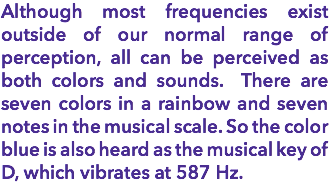
Some Scientific Insight
Vibrational Energy
Law of Vibration, a law of nature that states that ‘nothing rests; everything moves; every-thing vibrates.’ The lower the vibration, the slower the vibration; the higher the vibration the faster the vibration - Einstien - 1905
A molecular vibration occurs when atoms in a molecule are in periodic motion while the molecule as a whole has constant translational and rotational motion. The frequency of the periodic motion is known as a vibration frequency, and the typical frequencies of molecular vibrations range from less than 1012 to approximately 1014 Hz.
https://en.wikipedia.org/wiki/Molecular_vibration
"vibrational energy can be stored and transmitted in proteins"
McClare, C.W.F.: A “molecular energy” muscle model. J. Theor. Biol. 35, 569–595 (1972) [PubMed]
In 1974, Dr. Colin W.F. McClare, Ph.D, an Oxford University Bio-Physicist, discovered that frequencies of vibrating energy are roughly one-hundred times more efficient in relaying information within a biological system than physical signals, such as hormones, neurotransmitters and other growth factors.
Lipton, Bruce H. The Biology of Belief: Unleashing the Power of
Consciousness, Matter and Miracles. Hay House, 2008
https://hiddenlighthouse.wordpress.com/category/law-of-vibration/
For many years, the placebo effect was considered to be no more than a nuisance variable that needed to be controlled in clinical trials. Only recently have researchers redefined it as the key to understanding the healing that arises from medical ritual, the context of treatment, the patient-provider relationship and the power of imagination, hope and expectation.
Expectancy Effect in Three Mind-Body Clinical Trials
http://chp.sagepub.com/content/early/2016/06/03/2156587216652572.abstract
Mindfulness and Meditation
The Colors of the Visible Light Spectrum
430–480 THz
480–510 THz
510–540 THz
540–580 THz
580–610 THz
610–670 THz
670–750 THz
Wavelength
interval
Frequency
interval
Red
Orange
Yellow
Green
Cyan
Blue
Violet
700–635 nm
635–590 nm
590–560 nm
560–520 nm
520–490 nm
490–450 nm
450–400 nm
~
~
~
~
~
~
~
~
~
~
~
~
~
~

Suzy Chase-Motzkin
From a Center for Healthy Minds summit with HH the Dalai Lama on the practice of mindfulness - gaining strategies for coping with adversity


